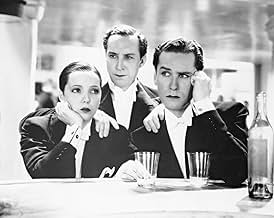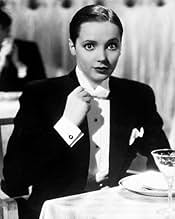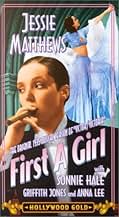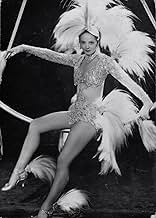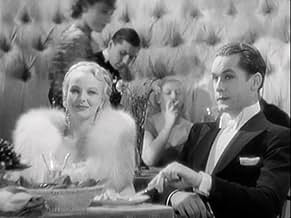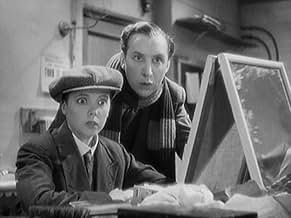Elizabeth dreams of being a music-hall singer. She gets to know Victor, that quite unexpectedly gets a female part in a music-hall number. He unfortunately finds himself voiceless, so, why w... Read allElizabeth dreams of being a music-hall singer. She gets to know Victor, that quite unexpectedly gets a female part in a music-hall number. He unfortunately finds himself voiceless, so, why wouldn't Elizabeth replace him in it?Elizabeth dreams of being a music-hall singer. She gets to know Victor, that quite unexpectedly gets a female part in a music-hall number. He unfortunately finds himself voiceless, so, why wouldn't Elizabeth replace him in it?
- Director
- Writers
- Stars
- Atlas
- (uncredited)
- Cast Member
- (uncredited)
- Cast Member
- (uncredited)
- Cast Member
- (uncredited)
- Man Serving in Cafe
- (uncredited)
- Reporter
- (uncredited)
- Director
- Writers
- All cast & crew
- Production, box office & more at IMDbPro
Featured reviews
Although Matthews was nicknamed "The Dancing Divinity", she does a bit more singing than dancing in this film, not surprising since she was reportedly a popular and prolific recording artist in England. In contrast to some of the dancing ladies of 1930s films, Matthews had a singing voice and didn't need dubbing.
Nevertheless, the dancing she does in this film admirably shows off her abilities. Although she was a proficient tap dancer, here she does not perform any rhythmic tap dances as she did in her other films. The tap dancing she does is more of a soft-shoe performed with co-star, Sonnie Hale, which turns into a nicely done ballroom-style dance, which is part of a large production number.
There is another big production number done with the typical chorus girls and a singer, in which Matthews does not participate. The other big production number features Matthews, again with chorus girls, in which she sings and then performs a freestyle type of dance.
The songs created for this film aren't particularly memorable, and none advanced to the category of "standard", although they are serviceable for the film. The composers may not have household names, but were certainly prolific in that day and you would recognize many of the other songs they have composed, some of which are standards.
It's interesting to see co-star Anna Lee in her early career, somewhat before her emigration to Hollywood, with her hair bleached to platinum blonde in the Jean Harlow style of the 1930s.
This film is interesting to watch, if you'd like to examine the work of Jessie Matthews, or if you just like musicals of the 1930s. This film can be obtained on VHS.
Musicals in the 1930s were stiff mash-ups of song and dance numbers until the geometric fantasies of Busby Berkeley and then the narrative Fred Astaire movies, both in beginning in 1933 and 1934. This is a weird 1935 British affair that's well-enough filmed to remind you of Berkeley but is tepid by comparison. And as for plot, it takes awhile to get to that, following some decent and sometimes almost surreal dance/fashion scenes.
This is, in short, the original movie version of "Victor/Victoria." Once you get into the story, which will still be interrupted by old-fashioned feeling dance numbers, you'll get the cross-dressing stuff. All in fun. The leading woman (who does the switching, just as Julie Andrews did in the famous remake) is Jessie Matthews, who is a sort of Ginger Rogers type with a doll face. It's the doll face, highly feminine, that removes some of the credibility of the story--she does look slightly like a boy, when dressed as a man, but it doesn't quite carry. And of course, the point is to fool at least the other characters. The leading man Victor, played by Sonnie Hale, is also a problem, at least for audiences today, because he lacks charm, or sincerity, or pathos, or whatever might carry him through along with Matthews. He is meant to be the set-up for what "Victoria" has to do. But he's usually too dull for his own good, or he tries too hard. Matthews, at least, is purely charming and delightful. By the final number, however, when the tables are turned once again, Victor comes into his own. You might see it coming, but then it's divine.
It gives nothing away to say that the changing identities ruse is eventually suspected and the tension then begins. It's all done with a bit of stiffness, and filmed with uniform bright intensity, which makes it all a bit superficial, but is still enjoyable.
Elizabeth (Jessie Matthews) is a British shop girl working in a fashion boutique that caters to the wealthy. She dreams of being a famous entertainer. One rainy day - while wearing the fancy clothes she is supposed to be delivering - she runs into Victor, aspiring Shakespearean actor and actual female impersonator who works the bawdy music halls of London. He is down to his last shilling when he gets a one-time engagement to work in one of these halls. Unfortunately, the rain has taken a toll on his voice and he is unable to take the job. Likewise, Elizabeth has ruined the clothes she was supposed to deliver and can't go back to her job. They forge an alliance for what is supposed to be a one-time thing - Elizabeth will go on as Victor and be a woman impersonating a man impersonating a woman so they both can collect the money they badly need. A high-class booking agent sees the act and offers the pair a chance to be the toast of Europe. A reluctant Elizabeth agrees since it does give her a chance at her dream.
The complications arise in France where a princess and her fiancé, which the princess treats more as a lapdog than a man, see her act. The fiancé arrives late to the performance and is at first attracted to Elizabeth, whom he believes is a woman performing as a woman. The princess enjoys telling him the joke is on him when she shows him the program that introduces Victoria - the great female impersonator.
The differences between this film and Victor/Victoria are that the princess sees her fiancé's attraction to "Bob" and yet wants to prove "Bob" to be a girl, opening up a pathway for a romance between the two, and also the princess starts a romance of sorts with Elizabeth's mentor, Victor. Thus the princess is not the jealous gun moll that Leslie Ann Warren plays in Victor/Victoria. Instead she is a Marie Antoinette-like character that seems to take nothing seriously. There are implausibilities in both films. In Victor/Victoria the film would lead you to believe that most of 1930's Paris is gay. In this film no trace of a gay lifestyle is ever mentioned. Instead Victor is supposed to be a straight man who lives in close quarters with the very attractive Elizabeth and apparently never has an impure thought or act. However, the rather unlikely pairing of Victor with the princess seems to be thrown in just so that the audience is assured of his straightness.
There are several very good Busby Berkeley-like musical numbers in the film as well as some very good and catchy tunes to go along with them.
It is still a lovely, happy picture with some really spectacular dance numbers. It's stylishly directed as usual by the maestro, Victor Saville and as a big, flashy musical it's much more impressive than what Hollywood was doing at the time (with the obvious exception of what Zanuck had overseen a few years earlier at Warners.)
Although it adds to the film's overall silliness, what is completely and utterly impossible for your mind to process is that just by cutting her hair, anyone could possibly believe that Jessie Matthews was a man. She was unquestionably the prettiest woman in movies back then (if not, the prettiest woman in the world?) The proposition is beyond sheer madness especially since she doesn't even change her voice, her makeup or her characteristic sensuous style of dancing.
What also seems impossible is that in real life this stunningly beautiful actress was married to Sonny Hale (her co star). Being kind, the nicest comment about his appearance could be be that he didn't have film star looks! However you can start to see what she saw in him. He does have an unusually engaging and warm personality which comes across really strongly in this picture. You might not think so at first but the more you watch him, the funnier he gets.
This is a great uplifting slice of joyful escapism. It's an absolute, absolute must for any fans of spectacular 1930s musicals and silly old-fashioned farces. For those of you unfamiliar with the goddess known as Jessie Matthews however, this one isn't as likely to make you fall in love with her as much as some of her other pictures.
Did you know
- TriviaThe long scarf worn prominently by Sonnie Hale during the early scenes had been knitted for him by Jessie Matthews on the set of her previous film, Toujours vingt ans (1934).
- GoofsVictor, the expert in Shakespeare quotes "Is love a tender thing? it is too rough, Too rude, too boisterous, and it pricks like thorn. If love be rough with you, be rough with love" ending with "As You Like It" not the actual "Romeo and Juliet" from which the quote is taken.
- Quotes
Victor: [to 'Bill', about Princess Mironoff] She doesn't know you. Smile!
[Bill smiles awkwardly at the Princess, Victor does so with broad masculine appreciation]
Victor: [aside] Not like *that*. A he-man smile; she's beautiful!
[Bill catches sight of the handsome Robert and her smile widens]
Victor: [acidly] I said the Princess, not the Prince...
- ConnectionsFeatured in Sailing Along (1938)
Details
- Runtime
- 1h 34m(94 min)
- Color
- Aspect ratio
- 1.37 : 1

